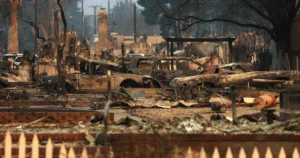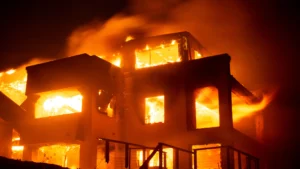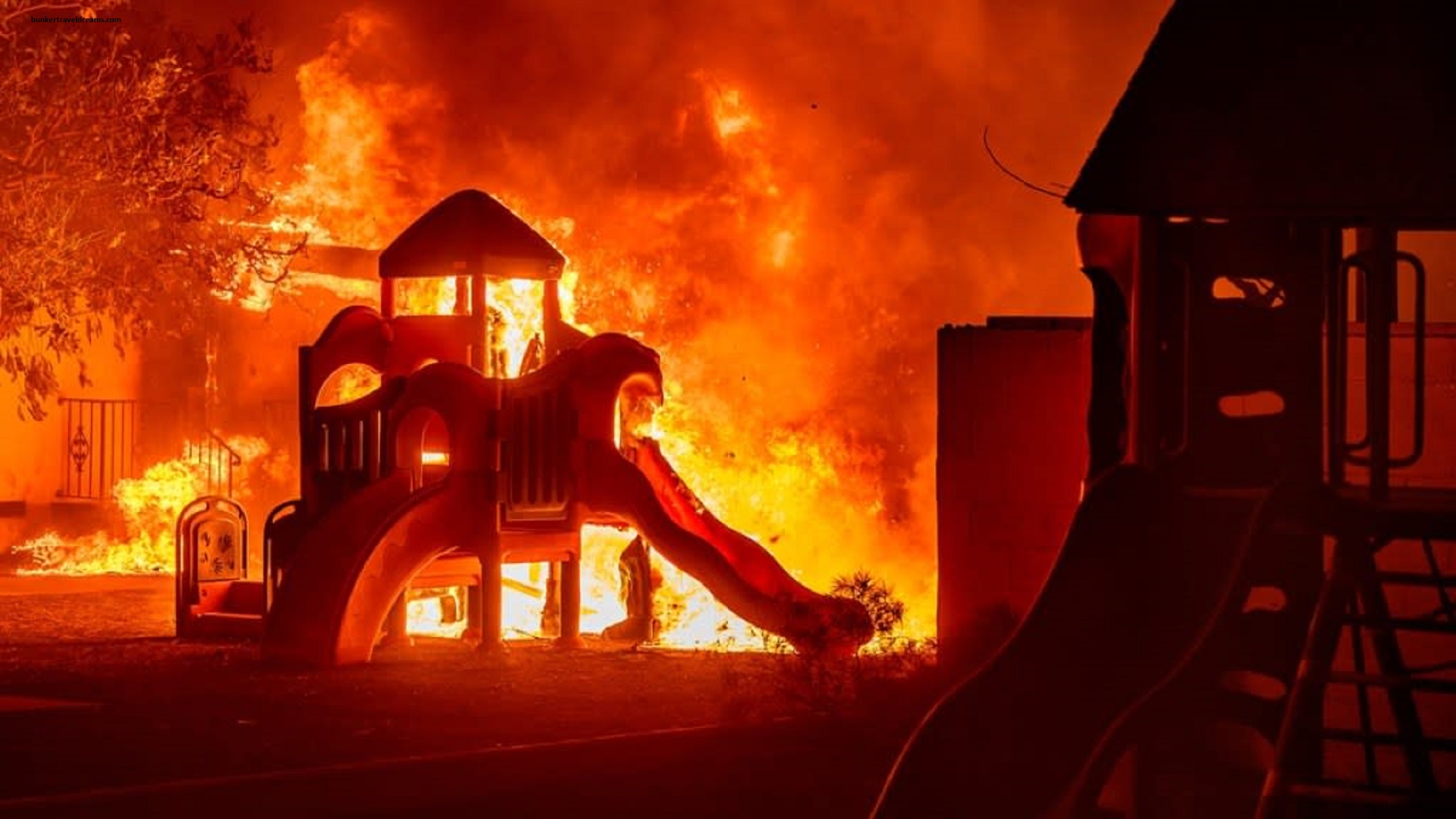Introduction
The Eaton Fire was a destructive wildfire in Los Angeles County, Southern California. The Eaton Fire was a wildfire that started in the San Gabriel Mountains of Los Angeles County, California, on January 7, 2025. It was fueled by strong Santa Ana winds and destroyed more than 9,000 buildings, including homes, schools, and businesses. The fire killed at least 17 people, making it the fifth deadliest wildfire in California history.
The Eaton Fire was one of multiple large wildfires in Southern California in January 2025 and burned simultaneously with the deadly and destructive Palisades Fire in the Santa Monica Mountains.
The cause of the fire is under investigation; news reports and lawsuits have focused on the possible involvement of power lines operated by electrical utility Southern California Edison. The fire was fully contained on January 31st.
How was Eaton Fire started?
Video from a gas station security camera shows what a new filing in a lawsuit alleges is the start of this month’s deadly Eaton Fire in the Los Angeles area—electric sparking at a utility transmission tower in the hilly Eaton Canyon area near the Altadena community.

Possible Causes of the Eaton Fire
Electrical Arcing and Power Lines
Attorneys, fire investigators, and electrical engineers suggest that the arcing may have originated from tower M16T1, where a sudden change in electricity reenergized the line. One possible explanation involves electromagnetic induction, which could have contributed to the ignition.
Extreme Fire Weather Conditions
Southern California experienced drought-like conditions combined with powerful offshore winds, creating an environment highly prone to wildfires. The National Weather Service described the fire weather as “about as bad as it gets.”
Potential Causes Under Investigation
Some theories suggest that the Eaton Fire in Pasadena may have been sparked by wind-felled power lines. Others propose that the Palisades Fire could have been triggered by embers from a smaller fire the previous week.
Progression of eaton fire
The Eaton Fire in Los Angeles County, California, grew rapidly in size and destroyed many structures. The fire’s progression was fueled by strong Santa Ana winds.
Growth
January 8: The fire grew to over 2,227 acres with no containment
January 12: The fire was 27% contained
January 16: The fire was 55% contained
January 18: The fire was 73% contained
January 31: The fire was fully contained after 24 days
Damage
- The fire destroyed over 9,400 structures, mostly in the Altadena community
- The fire was one of the deadliest and most destructive wildfires in California’s history
- The fire, along with the Palisades Fire, created the worst natural disaster in Los Angeles County history
Response
- Residents were forced to flee their homes
- Evacuation shelters were set up
- Damage inspection teams were sent to assess the damage
Broader Context and Impact of the Eaton Fire
The Eaton Fire, which recently ravaged parts of Altadena and Pasadena, California, had a significant impact beyond immediate property damage, causing widespread disruption to local communities, disproportionately affecting the Black population in Altadena due to historical redlining practices, and raising concerns about the potential loss of generational wealth within the community, all while highlighting the increasing dangers of wildfire season exacerbated by climate change; the fire also led to large-scale evacuations, impacting schools, businesses, and critical infrastructure like the NASA Jet Propulsion Laboratory, and resulted in substantial environmental damage including air and water contamination.

Key points about the broader context and impact of the Eaton Fire:
Disproportionate impact on Black community:
Due to historical redlining, a large percentage of Black residents in Altadena lived in areas directly affected by the fire, leading to a higher rate of home destruction and displacement within this demographic.
Generational wealth disruption:
The fire’s destruction of homes, particularly those passed down through generations, threatens the ability of Black families in Altadena to transfer wealth to younger generations.
Climate change concerns:
The severity of the Eaton Fire is seen as another indicator of the growing threat of wildfires due to climate change, including drier conditions and stronger winds.
Community displacement and disruption:
Large-scale evacuations caused major disruptions to daily life, impacting schools, businesses, and essential services.
Historical site damage:
The fire also destroyed several historically significant buildings in Altadena, contributing to a sense of cultural loss.
Environmental concerns:
Aside from immediate destruction, the fire also raised concerns about potential long-term environmental impacts, including air and water contamination from ash and debris.
Structures destroyed
In January 2025, wildfires in Los Angeles County, California destroyed more than 10,000 structures, including homes, businesses, and vehicles. The fires also damaged schools and famous landmarks.
Number of structures destroyed
- Eaton Fire: Destroyed 9,413 structures, including homes, businesses, and vehicles
- Palisades Fire: Destroyed 6,822 structures, including homes in Pacific Palisades
- Kenneth Fire: Ignited near West Hills, a densely populated neighborhood
Famous landmarks destroyed
- Bunny Museum: A Guinness World Record certified museum in Altadena, California
- Will Rogers State Historic Museum: A famous landmark destroyed by the fires
- Topanga Ranch Motel: A famous landmark destroyed by the fires
- Other effects The fires displaced thousands of people, The fires caused significant injuries, and The fires killed two people.
Causes
- The fires were fueled by strong winds and dry conditions
Evacuation Orders and Public Safety Measures
The Eaton Fire in California, which started in January 2025, resulted in evacuation orders and warnings for residents in several cities. The fire was fueled by strong Santa Ana winds and grew to 14,120 acres.
Evacuation orders
Evacuation orders were issued for residents of Altadena, Kinneloa Mesa, La Canada Flintridge, and parts of Sierra Madre, Pasadena, Arcadia, and Monrovia. Evacuation zones were subject to a curfew from 6 PM–6 AM.
Public safety measures
- Residents were advised to wait for official clearance before reentering their homes.
- Residents were required to provide proof of residency to re-enter their homes.
- Residents were advised to wear NIOSH-approved respirators, gloves, safety goggles, long-sleeved shirts, long pants, and shoes with socks when cleaning up.
- Residents were advised to wash off ash from their skin, eyes, or mouth as soon as possible.
- Residents were advised to shower regularly throughout the day when cleaning areas with ash.
- Residents were advised to keep children and pets away from ash and cleanup activities.
- Residents were advised to avoid cleanup activities if they have heart or lung disease, are older adults, or are pregnant.
Resources
- The CAL FIRE 3D map can be used to identify evacuation zones.
- The Genasys Project can be used to receive updates for evacuation zones.
- The Red Cross can be contacted at (800) 675-5799 for information about people impacted by the fires.
Moving Forward After the Eaton Fire Containment
Following the containment of the Eaton Fire, the primary focus will shift towards recovery efforts, including damage assessments, debris removal, infrastructure repairs, repopulation of evacuated areas, mental health support for affected residents, and long-term rebuilding plans, while remaining vigilant against potential flare-ups due to ongoing dry conditions and the need for improved fire safety measures in the affected regions.
Key aspects of moving forward:
Damage Assessment and Insurance Claims:Comprehensive evaluation of the destruction caused by the fire, including damaged homes, businesses, and infrastructure, to facilitate insurance claims and aid in rebuilding efforts.
Debris Removal:
Clearing debris from burned areas to prevent hazards and facilitate access for repairs and reconstruction.
Infrastructure Restoration:
Repairing damaged utilities like power lines, gas pipes, and water systems to restore essential services.
Phased Repopulation:
Gradually allowing residents to return to their homes in a controlled manner, prioritizing areas with restored utilities and safety assessments.
Mental Health Support:
Providing psychological counseling and support services to individuals impacted by the fire to address trauma and stress.
Community Recovery Planning:
Collaboration between local government, residents, and non-profit organizations to develop a comprehensive plan for rebuilding and long-term community resilience.
Fire Safety Measures:
Implementing measures to mitigate fire risks in the future, such as vegetation management, improved building codes, and public education campaigns.
Investigation and Accountability:
Thorough investigation of the fire’s origin to identify potential causes and implement preventative measures.
Challenges to Consider:
Extent of Damage:
The significant destruction caused by the Eaton Fire could lead to lengthy recovery processes and potential housing shortages.
Financial Strain:
The cost of rebuilding could place a significant burden on individuals, communities, and insurance providers.
Environmental Impact:
Assessing and addressing potential environmental consequences of the fire, including soil erosion and impacts on wildlife habitats.
Community Disruption:
The social and economic disruption caused by displacement and the loss of homes and businesses. Overall, the focus after the Eaton Fire containment will be on supporting affected communities through a comprehensive recovery process, prioritizing the safety and well-being of residents while working towards rebuilding and enhancing resilience to future wildfire threats.
Conclusion
California wildfires are driven by a combination of natural and human factors, including extreme weather conditions, electrical failures, and human activities. The state’s dry climate, strong winds, and prolonged droughts create an environment where fires can ignite and spread rapidly.Investigations of big fires, such as the Eaton Fire and Palisades Fire, show the significance of power lines, electromagnetic induction, and embers from past flames as potential causes. Additionally, human irresponsibility, such as vehicles idling over parched grass or unattended campfires, can also lead to fire breakouts.
FAQs
Where is the Eaton California fire?
The Eaton Fire, located north of Pasadena, ended up burning over 14,000 acres. It destroyed nearly 10,000 homes, businesses, schools, and other structures and caused at least 17 confirmed deaths. South-west of the Eaton Fire, the Palisades Fire burned almost 24,000 acres between Malibu and Santa Monica.
How many people died in the California wildfires?
At least 29 people have died in the fires, according to Los Angeles County officials. The county medical examiner’s office is still investigating many of the deaths. The department noted that it cannot confirm human remains until it processes them at its facility.



